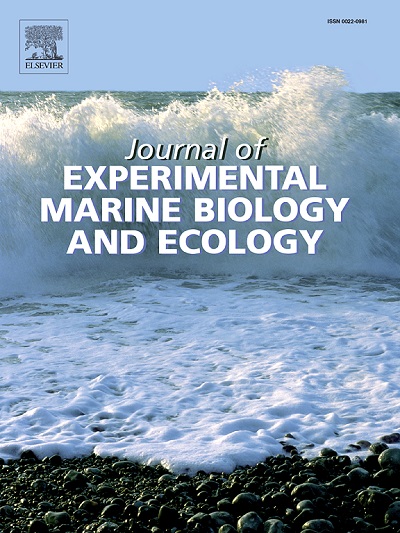对南非本格拉生态系统中主要食草动物花斑蝶密度的实验操作对岩岸群落组成的影响
IF 1.8
3区 生物学
Q3 ECOLOGY
Journal of Experimental Marine Biology and Ecology
Pub Date : 2024-10-31
DOI:10.1016/j.jembe.2024.152065
引用次数: 0
摘要
在南非开普半岛西海岸的一个禁捕海洋保护区内的两个地点,采用从零到最大自然密度的四个处理水平以及对照地块,对一种常见的采捕潮间带瓣鳃藻Cymbula granatina的密度进行了控制,以评估不同采捕强度对岩岸群落组成的影响。在移除或稀释花叶珊瑚后,群落组成发生了变化:皮质藻类和瞬生藻类的覆盖率增加,而包壳珊瑚的覆盖率下降。随着帽贝密度的降低,岩石上的棕色包壳藻 Pseudoralfsia verrucosa 数量增加,但贝壳上的数量减少。不过,这些结果取决于所考虑的时间范围,因为大型藻类每年都会发生周期性变化,而清除瓣鳃纲的影响主要体现在大型藻类大量繁殖的夏季上升流季节。这些发现具有重要的管理意义,特别是将这种瓣鳃藻的数量减少到自然密度的 50% 以下,将极大地改变群落组成,特别是在增加大型藻类的同时减少包壳珊瑚,并可能对其他物种的演替和繁殖产生次生影响。本文章由计算机程序翻译,如有差异,请以英文原文为准。

Effects of experimental manipulations of the density of a key grazer Cymbula granatina on rocky-shore community composition in the Benguela ecosystem, South Africa
Densities of a commonly-harvested intertidal limpet Cymbula granatina were manipulated at two sites within a no-take marine protected area on the west coast of the Cape Peninsula in South Africa, using four treatment levels ranging from zero to maximum natural densities, together with control plots, to evaluate the effects of different harvesting intensities on rocky-shore community composition. Following removal or thinning of C. granatina, community composition changed: cover of corticated and ephemeral algae increased and that of encrusting corallines decreased. As limpet density fell, abundance of the brown encrusting alga Pseudoralfsia verrucosa increased on rock but decreased on shells. These outcomes were, however, dependent on the time frames considered, as macroalgae underwent annual cycles, and the effects of limpet removal were evident predominantly during the summer upwelling season when macroalgae proliferated. There are important management implications arising from these finding, notably that any reductions of this limpet to levels below 50 % of natural densities will profoundly alter community composition, particularly increasing macroalgae while decreasing encrusting corallines, with likely secondary effects on succession and recruitment of other species.
求助全文
通过发布文献求助,成功后即可免费获取论文全文。
去求助
来源期刊
CiteScore
4.30
自引率
0.00%
发文量
98
审稿时长
14 weeks
期刊介绍:
The Journal of Experimental Marine Biology and Ecology provides a forum for experimental ecological research on marine organisms in relation to their environment. Topic areas include studies that focus on biochemistry, physiology, behavior, genetics, and ecological theory. The main emphasis of the Journal lies in hypothesis driven experimental work, both from the laboratory and the field. Natural experiments or descriptive studies that elucidate fundamental ecological processes are welcome. Submissions should have a broad ecological framework beyond the specific study organism or geographic region.
Short communications that highlight emerging issues and exciting discoveries within five printed pages will receive a rapid turnaround. Papers describing important new analytical, computational, experimental and theoretical techniques and methods are encouraged and will be highlighted as Methodological Advances. We welcome proposals for Review Papers synthesizing a specific field within marine ecology. Finally, the journal aims to publish Special Issues at regular intervals synthesizing a particular field of marine science. All printed papers undergo a peer review process before being accepted and will receive a first decision within three months.

 求助内容:
求助内容: 应助结果提醒方式:
应助结果提醒方式:


